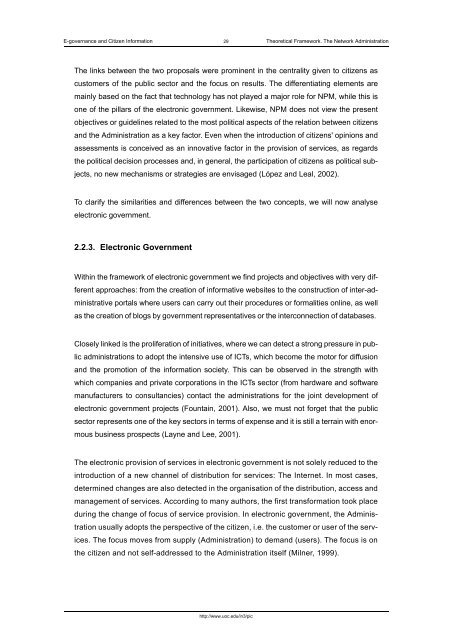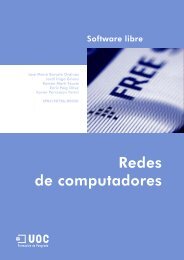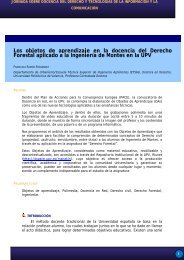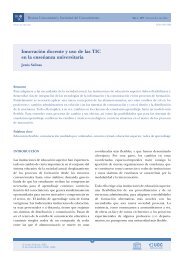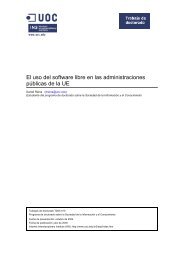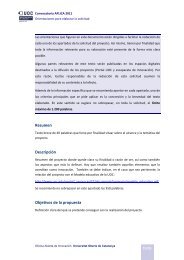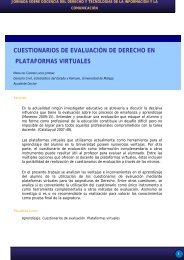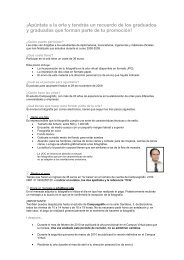e-governance and citizen information - Universitat Oberta de ...
e-governance and citizen information - Universitat Oberta de ...
e-governance and citizen information - Universitat Oberta de ...
Create successful ePaper yourself
Turn your PDF publications into a flip-book with our unique Google optimized e-Paper software.
E-<strong>governance</strong> <strong>and</strong> Citizen Information 29 Theoretical Framework. The Network AdministrationThe links between the two proposals were prominent in the centrality given to <strong>citizen</strong>s ascustomers of the public sector <strong>and</strong> the focus on results. The differentiating elements aremainly based on the fact that technology has not played a major role for NPM, while this isone of the pillars of the electronic government. Likewise, NPM does not view the presentobjectives or gui<strong>de</strong>lines related to the most political aspects of the relation between <strong>citizen</strong>s<strong>and</strong> the Administration as a key factor. Even when the introduction of <strong>citizen</strong>s' opinions <strong>and</strong>assessments is conceived as an innovative factor in the provision of services, as regardsthe political <strong>de</strong>cision processes <strong>and</strong>, in general, the participation of <strong>citizen</strong>s as political subjects,no new mechanisms or strategies are envisaged (López <strong>and</strong> Leal, 2002).To clarify the similarities <strong>and</strong> differences between the two concepts, we will now analyseelectronic government.2.2.3. Electronic GovernmentWithin the framework of electronic government we find projects <strong>and</strong> objectives with very differentapproaches: from the creation of informative websites to the construction of inter-administrativeportals where users can carry out their procedures or formalities online, as wellas the creation of blogs by government representatives or the interconnection of databases.Closely linked is the proliferation of initiatives, where we can <strong>de</strong>tect a strong pressure in publicadministrations to adopt the intensive use of ICTs, which become the motor for diffusion<strong>and</strong> the promotion of the <strong>information</strong> society. This can be observed in the strength withwhich companies <strong>and</strong> private corporations in the ICTs sector (from hardware <strong>and</strong> softwaremanufacturers to consultancies) contact the administrations for the joint <strong>de</strong>velopment ofelectronic government projects (Fountain, 2001). Also, we must not forget that the publicsector represents one of the key sectors in terms of expense <strong>and</strong> it is still a terrain with enormousbusiness prospects (Layne <strong>and</strong> Lee, 2001).The electronic provision of services in electronic government is not solely reduced to theintroduction of a new channel of distribution for services: The Internet. In most cases,<strong>de</strong>termined changes are also <strong>de</strong>tected in the organisation of the distribution, access <strong>and</strong>management of services. According to many authors, the first transformation took placeduring the change of focus of service provision. In electronic government, the Administrationusually adopts the perspective of the <strong>citizen</strong>, i.e. the customer or user of the services.The focus moves from supply (Administration) to <strong>de</strong>m<strong>and</strong> (users). The focus is onthe <strong>citizen</strong> <strong>and</strong> not self-addressed to the Administration itself (Milner, 1999).http://www.uoc.edu/in3/pic


